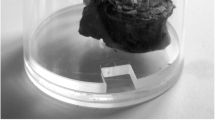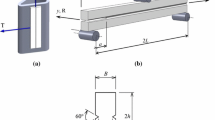Abstract
Mechanical fatigue of bone leads to micro-cracking which is associated with remodeling, establishing a balance in the microcrack population of the living tissue, thus, in the steady-state, the microstructure of bone provides sites of discontinuity acting as stress raisers. Hence fracture toughness plays a decisive role in bone functionality by determining the level to which the material can be stressed in the presence of cracks, or, equivalently, the magnitude of cracking which can be tolerated at a given stress level. Cortical bone, which behaves as a quasi-brittle solid when fractured, was tested as short-rod chevron-notched tension specimens (CNT). The main features of the CNT specimen are its geometry and the V shaped notch. The notch leads to steady-state crack propagation whilst the requested geometry allows a diameter 40% smaller than the thickness of a standard compact tension specimens (CT). These features are essential to distinguish the inhomogeneties in the fracture properties of materials like bone. Bone structure and crack propagation of the CNT specimens were analyzed using X-ray computed micro-tomography (XMT), which is a non-invasive imaging technique. The unique feature of the micro-CT is the high resolution three-dimensional image which consists of multi-sliced tomographs taken in a fine pitch along the rotational axis. Fracture toughness (K IC) computed according to the peak load was 4.8 MNm-3/2 while that derived from experimental calibration tests using XMT was 4.9 MNm-3/2.
Similar content being viewed by others
References
R. S. LAKES, S. NAKAMIRA, J. C. BEHIRI and W. BONFIELD, J. Biomech. 10 (1990) 967.
J. D. CURREY, J. Microsc. Sci. 103 (1962) 11.
W. BONFIELD and P. K. DATTA, J. Biomech. 9 (1976) 131.
D. VASHISHTH, J. C. BEHIRI and W. BONFIELD, ibid. 30 (1997) 763.
T. L. NORMAN, D. VASHISHTH and D. BURT, ibid. 28 (1995) 309.
F. G. EVANS and R. VINCENTELLI, ibid. 2 (1969) 63.
D. B. BURR, M. B. SCHAFFLER and R. G. FREDERICKSON, ibid. 11 (1988) 939.
A. SIMKIN and G. ROBIN, 7 (1974) 183.
R. B. MARTIN and D. B. BURR, J. Biomech. 15 (1982) 137.
X. E. GUO, L. C. LIANG and S. A. GOLDSTEIN, J. Biom. Engin. 120 (1998) 112.
M. B. SCHAFFER, K. CHOI and C. MILGROM, Bone 17 (1995) 521.
T. L. NORMAN and Z. WANG, ibid. 20 (1997) 375.
A. C. COURTNEY, W. C. HAYES and L. J. GIBSON, J. Biomech. 29 (1996) 1463.
B. MARTIN, Calc. Tiss. Int. 53 supll. 1 (1993) S34.
L. E. CLAES, H. J. WILKE and H. KIEFER, J. Biomech. 28 (1995) 1377.
D. M. ROBERTSON, D. ROBERTSON and C. G. BARRET, ibid. 11 (1978) 359.
T. M. WRIGHT and W. C. HAYES, ibid. 10 (1977) 419.
J. C. BEHIRI and W. BONFIELD, ibid. 17 (1984) 25.
T. L. NORMAN, D. VASHISHTH and D. BURR, ibid. 29 (1996) 102.
W. BONFIELD, ibid. 20 (1987) 1071.
J. W. MELVIN and F. G. EVANS, Biomechanics Symposium ASME (New York, 1973) 87.
D. MOYLE and A. J. GAVENS, J. Biomech. 19 (1986) 919.
X. WANG and C. M. AGRAWAL, J. Biom. Mat. Res. 33 (1996) 13.
ASTM Standards E 399-72, Standard Method of Test for Plane-Strain Fracture Toughness of Metallic materials.
J. W. MELVIN, J. Biomech. Eng. 115 (1993) 549.
J. C. BEHIRI and W. BONFIELD, J. Biomech. 22 (1989) 863.
G. R. DAVIS and J. C. ELLIOT, Nucl. Instr. Meth. Phys. Res. A394 (1997) 157.
W. GRAEFF and K. ENGELKE in “Microradiography and microtomography”, S. Ebashi, M. Kohc, E. Rubenstein (North Holland, Amsterdam 1991) 361.
J. C. ELLIOT, P. ANDERSON, X. J. GAO, F. S. L. WONG, G. R. DAVIS and S. E. P. DOWKER, J. X-ray Sci. and Tech. 4 (1994) 102.
ASTM Standards B 771-87, Standard Test for Short Rod Fracture Toughness of Cemented Carbides.
http://www.terratek.com7fracto_2.htm
D. P. H. HASSELMAN and F. F. LANGE in “Fracture Mechanics of Ceramics” Vol. 3, Edited by R.C. Bradt (Plenum Press, New York, 1978) 483.
L. M. BARKER, Int. Fract. Mech. 9 (1977) 361.
L. S. COSTIN, in “symposium on fracture mechanics for ceramics, rocks and concrete”. Chicago, June 1980 ( printed in Baltimora 1981) 169.
B. P. FLANNERY, H. W. DECKMAN, W. G. ROBERGE and K. L. D'AMICO, Science 237 (1987) 1439.
B. P. FLANNERY and W. G. ROBERGE, J. Appl. Phys. 62 (1987) 4668.
G. R. DAVIS and FERRANTIS. L. WONG, Physiol. Meas. 17 (1996) 121.
J. C. ELLIOT, G. R. DAVIS, FERRANTIS. L. WONG, STEPHANIE E. P. DOWKER and C. E. MERCER, Anal. Quimica 93 (1997) S77.
D. T. REILLY, A. H. BURSTEIN and V. H. FRANKEL, J. Biomech. 7 (1974) 271.
D. T. REILLY and A. H. BURSTEIN, J. Bone and Joint Surgery 56-A (1974) 1001.
R. T. BUBSEY, D. MUNZ, W. S. PIERCE and J. L. SHANNON JR., Int. J. of Fracture 18 (1982) 125.
J. C. NEWMAN, in “Chevron-Notched Specimens” (Underwood, Freiman and Baratta editors, printed in Baltimora 1984) 5.
T. AKATSU, E. YASUDA and M. SAKAI, in “Fracture Mechanics of Ceramics”, vol. 11, Ed. R. C. Bradt et al. (Plenum Press, New York 1996) 245.
L. M. BARKER, Engng Fract. Mech. 17 (1983) 289.
T. LANG, B. H. HASEGAWA, S. C. LIEW, J. K. BROWN, S. C. BLANKSPOOR, S. M. REILLY, E. L. GINGOLD and C. E. CANN, J. Nucl. Med. 33 (1992) 1881.
F. G. EVANS and K. T. FABER, J. of Am. Ceramic Soc. 67 (1984) 255.
B. CHARALAMBIDES, M. Phil. thesis, University of London.
T. L. ANDERSON in “Fracture Mechanics: foundamental and applications”, CRC Press, Boca Raton, F.L., 1990.
S. SURESH in “Fatigue of materials”, Cambridge Univ. Press, D.R. Clarke Ed., Great Britain, 1991.
D. MUNZ, R. T. BUBSEY and J. E. SRAWLEY, Int. Jour. Fract. 16 (1980) 354-374.
Author information
Authors and Affiliations
Rights and permissions
About this article
Cite this article
Santis, R.D., Anderson, P., Tanner, K.E. et al. Bone fracture analysis on the short rod chevron-notch specimens using the X-ray computer micro-tomography. Journal of Materials Science: Materials in Medicine 11, 629–636 (2000). https://doi.org/10.1023/A:1008909830421
Issue Date:
DOI: https://doi.org/10.1023/A:1008909830421




